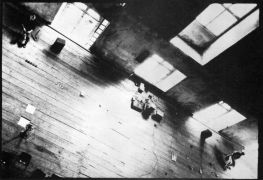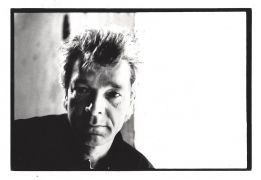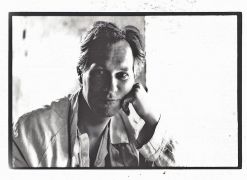"The intention for Victor Wentink and Horst Rickel to work at Plasy was to work quietly on new ideas for future music performances. The ideal location of Plasy and the many acoustic spaces would create good possibilities for exploring materials and testing ideas. Horst Rickel wanted to test his new Korg M1 in combination with pure acoustic sources, and Wentink and Rickel were going to demonstrate new music computer software and writing on a new text on art and technology to be published in 1993. Four concerts were presented in total. Three for audiences in the monastery Plasy and one in Prague in the Club Delta. Two were duo-concerts and two (including the one in Prague) were solo-concerts by Wentink.
In Plasy, there was material at hand that could be used as a sound-source in combination with pure computer-controlled electronic sounds. Especially the otherwise hard to get sink kitchen-ware that was to be found in the village stores was perfect for acoustic and electrically amplified sound production. The first public opening performance of the Hermit Project at the monastery was given by Victor Wentink and Horst Rickel with this material in the Refectory hall of the monastery at the 12th of June.
Horst Rickel did some experiments with his foot-driven organ pipe combined with singing at the st. Bernard chapel for the special acoustics in that space. He also made a new piece for piano that was performed on a grand piano in the corridor of the main convent building, while the audience was walking around listening from different positions to the piano 'soundwaves.'
Victor Wentink made contact with a group of four dancers who were also working in the Monastery to try out a dance performance on one of his electronic music pieces. The first attempt was presented in the Metternich Hall of the prelature at the last performance day. A further cooperation will take place in the Netherlands."
Victor Wentink and Horst Rickels, Plasy 1992
Victor Wentink (born 1948 in Enschede) is a Dutch composer and theorist. He is known as a pioneer in electronic and electro-instrumentical music, but also worked in theater works, music-machines and technological projects. In 1966, he started to study piano and electronic composition with Dick Raaijmakers at the Koninklijk Conservatorium. Since 1973, he has followed the multimedia class at the Vrie Academie in Den Haag. In 2006, he received a Master degree for his thesis on "Art and Science."
In 1969, together with Dick Raaijmakers and Gilius van Begeik, he founded the electro-instrumental ensemble Het Leven. He also taught electro-instrumental music at the Koninlijke Conservatorium (1973-1974) and electronic composition at the Brabants Conservatorium (1972-1977). Between 1971 and 1982, he worked at the Steim (Stichting Elektro-Instrumentale Muziek) in Amsterdam, where he constructed the composing machine - Eemnes Machine (1975–1979) - which was exhibited at the Tektonikexhibition in the Haags Gemeentemuseum (1979).
Between 1984 and 1998, Wentink was involved in music and art organisations in Den Haag (Ooyevaer Desk, stichting Poenix, Theater Zeebelt, Theater Korzo). He participated in Dick Raaijmakers exhibition project Anto Qua Musica (1989), theater pieces with Horst Rickels (1992–1994), the digital opera Pearl Harbour (with Remko Scha), het Waterpaviljoen in Zeeland (with Edwin van der Heide) (1995–1997) and the manifestation Ne-onatur.


